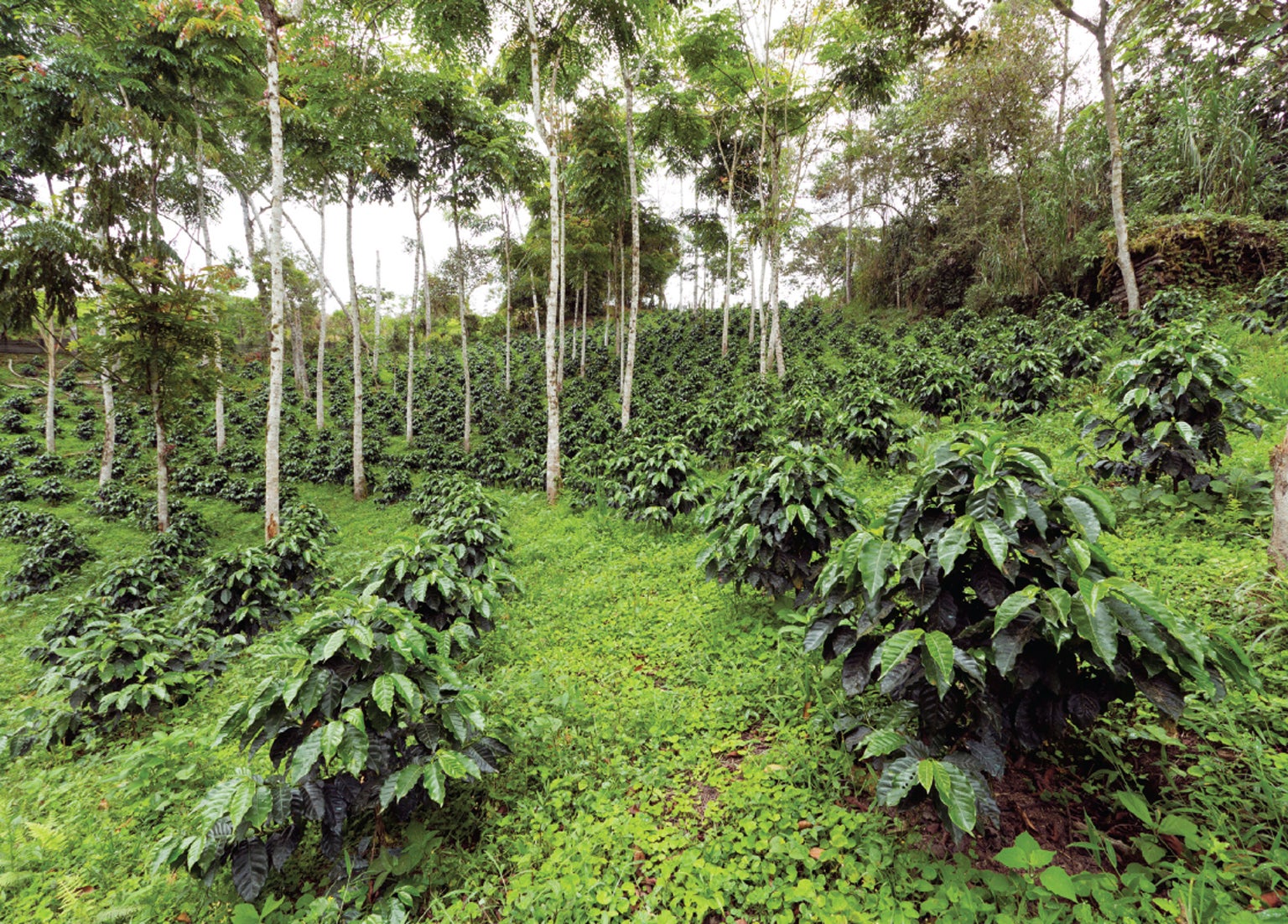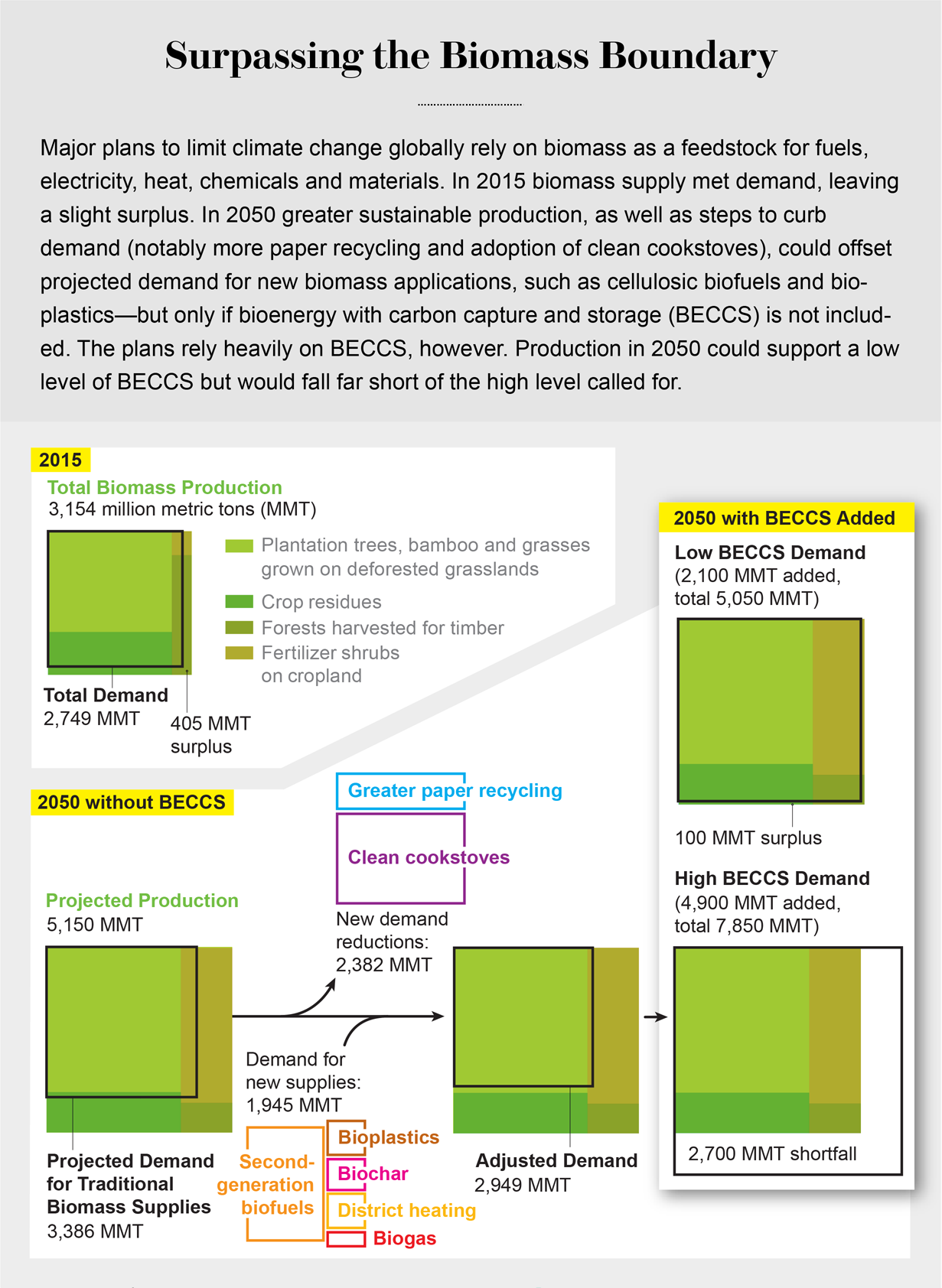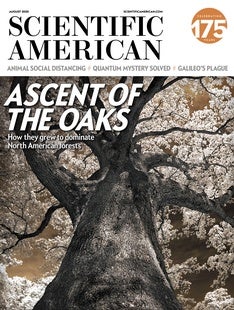In the flat farmland outside Decatur, Ill., a dump truck filled with ears of corn rolls into a warehouse at one end of an ethanol plant run by commodities giant Archer-Daniels-Midland Company. The corn is sent into a big fermentation vat that converts it to ethanol, which will be trucked to a refinery that will blend it with gasoline for sale nationwide. The fermentation process releases carbon dioxide, which is captured in a large flue, then sent by pipeline to a wellhead. Pumps send the gas deep belowground, where it will become trapped in sandstone rock.
This pilot project is about to complete its three-year trial as a novel way to pull carbon dioxide from the atmosphere while providing a viable commercial product that pays the bill. The CO2 is soaked up by the corn plants as they grow; injecting the gas into the sandstone permanently stores it.
But the use of corn for fuel, which accelerated in the U.S. in the 2000s, is controversial. Corn could feed people and livestock; growing plants for biofuel takes land that could otherwise be used to grow crops. Burning ethanol in cars produces new CO2 emissions, as does harvesting and trucking the corn. Fermenting, pipelining and injecting all require energy that, in the Midwest at least, may come from fossil fuels. It is unclear whether corn-based ethanol can yield even a small net reduction in atmospheric CO2.
The Decatur plant is one example of a suite of processes known as bioenergy with carbon capture and storage, or BECCS. Although the facility uses grains, most techniques target woody plants, including trees, shrubs and grasses, which are converted into liquid fuels or burned to create electricity. The emissions from those activities could be sequestered underground or collected and sold as a raw material—primarily for chemical plants or to pump into stubborn oil deposits to force out more oil.
Ignored for the most part 10 years ago, biomass is now being given an important role in the blueprints to lessen climate change. The list of applications is long and growing; in addition to biofuels, it includes biomass burning for electricity and heat, biodigesters that create commercial methane, biochar to improve soil, as well as insulation, building materials and bioplastics. The road maps that depend heavily on biomass include the 2018 Global Warming of 1.5 °C report by the Intergovernmental Panel on Climate Change (IPCC) and its 2019 special report Climate Change and Land; the U.S. National Climate Assessment released in November 2018; and Project Drawdown’s scenarios in its 2020 The Drawdown Review. Powerful industries such as electricity, fuel and plastics are betting big on biomass as a feedstock, pushing projected demand sky-high.
The scientific consensus behind the road maps is that to preserve a climate suitable for civilization, global warming should be limited to 1.5 degrees Celsius above preindustrial levels. This requires a 45 percent reduction of emissions by 2030 and zero net emissions by 2050, relative to 2010 levels, according to the IPCC’s 1.5 °C report. Humanity’s remaining carbon budget—the amount of future emissions that can be tolerated before surpassing 1.5 °C—is 420 billion to 580 billion metric tons. Staying within that limit requires slashing emissions as well as pulling CO2 from the atmosphere. The IPCC estimates that BECCS could sequester 0.4 billion to 11.3 billion tons a year. Project Drawdown does not include BECCS but calculates an average of 1.1 billion to 2.5 billion tons a year from other biomass applications.
The problem is that most plans assume they can have as much biomass as they want. The truth is that the land needed to produce all that biomass poses a serious constraint. The IPCC reports that large-scale implementation of BECCS alone would require 300 million to 700 million hectares (Mha) of land—an area roughly equivalent to that of India (328 Mha) or the continent of Australia (769 Mha). And most of the land suitable for BECCS is used today for agriculture.
Growing biomass for BECCS at that scale, to say nothing of the other applications, would come into serious conflict with the farmland required to produce food crops and the pastureland needed for livestock. Forests would also be vulnerable because the plans call for cutting them for biomass and replacing them with single-species plantations of high-yielding eucalypts or pines—large monocultures that ruin biodiversity.
It is possible that modest consumption of biomass for carbon sequestration could be sustainable. A few approaches even improve crop yields as well as woody plant production. But the projected demand is exceedingly high. BECCS is the elephant in the room. The IPCC and other organizations have put almost all their biomass eggs into this one basket, even though there are only about five small BECCS demonstration projects worldwide, according to the Global Carbon Capture and Storage Institute. That is a risky strategy to mitigate climate change.
Greatly increased demand for biomass will further aggravate what has already become a major struggle over how land will be used in the future. Tension is rising over whether more land should be put into soybeans to feed cattle to meet increasing demand for meat, whether cropland should be used to produce biofuels to replace fossil fuels, and how forests can be preserved instead of cut down. Limitless options are not possible on a planet that has inherent limits. A global scramble for biomass has begun, and unless some significant changes in expectations are made, governments and industries will end up colliding.

The Coming Scramble
Our species has always relied on biomass to meet basic needs, with virtually no thought about how much we are using. Woody plants have long been essential for making tools, homes, buildings, ships, mats, rugs, paper and cardboard. Bamboo has more than 1,500 documented uses. Since our earliest days biomass has literally provided the fuel for our fires. More than three billion people still cook over wood fires daily.
In the mid-1800s societies began to shift from wood to fossil fuels for energy, materials and chemicals. This dependency is the basis for civilization’s current prosperity but has also brought us to the brink of climate catastrophe.
Most biomass harvested today—more properly called lignocellulosic biomass—comes from trees, bamboo, herbaceous grasses and crop residues such as cornstalks. Biomass has become an attractive climate solution because it is, to some degree, renewable—it can be grown again and again.
BECCS is the dominant source of biomass identified in all the plans. It is still mostly a theoretical process, capturing CO2 emissions using the same technology that would scrub the gas from fossil-fuel power plants. The biggest issue is the volume of biomass that would be needed. In its 1.5 °C report, the IPCC states that all pathways that limit global warming to 1.5 °C or 2.0 °C require removing carbon dioxide from the atmosphere, on the order of 100 billion to 1,000 billion tons over the 21st century. Removal includes replanting forests, and farming practices can help sequester carbon in soils and perennial plants, but in the IPCC’s scheme, BECCS is cast as the primary tool to stay within the global carbon budget. Converting 300 million to 700 million hectares of cropland to biomass production is simply incompatible with increased food needs.
If food production is not negotiable, it is hard to find significant land. Some previously abandoned cropland could be brought back into production of biomass crops that can grow on that marginal soil, but ranchers and pastoralists already graze livestock on a fair share of this area, much of it being pasture. Meanwhile, to us, cutting into forests to create biomass plantations—something that the big climate plans say is undesirable but inevitable if global emissions are not rapidly reduced—is a nonstarter. Forests are important sinks of carbon; deforestation is already the source of 9 percent of anthropogenic emissions. To draw down carbon dioxide and to preserve biodiversity, forests must be protected and expanded, not razed. Project Drawdown’s projections are somewhat unique in that they only consider new sources of supply that do not undermine food security or increased forest protection and restoration.
Pathways to 1.5 °C that do not involve BECCS still require unrealistic amounts of biomass. The world’s limitless appetite for liquid biofuels is also unsustainable; there simply is not enough cropland to grow feedstock to replace the vast amounts of fuels we use. If 100 percent of all the corn grown in the U.S. was fermented into ethanol, that would meet only 25 percent of the nation’s gasoline and diesel demand—and it would leave no corn for people or animals.
To see what level of BECCS deployment might push the world’s biomass and food supplies into unsustainable territory, we analyzed the total amount of biomass used worldwide for all purposes in 2015 and then projected demand to 2050, including both low and high levels of BECCS as called for in the major reports. In both scenarios, increasing supply, alone, could not meet demand without deforestation. Reducing demand, alone, could not keep production within the planet’s biomass capacity. Only by aggressively reducing certain demands while aggressively increasing certain forms of supply was it possible to provide the biomass needed—for the case of modest dependency on BECCS [see graphic below]. Meeting the high-BECCS scenario ended up requiring 450 Mha of land, more than the area of the European Union.
Even the low-BECCS case raises great social concerns. Much of the land needed is now farmed by smallholders, grazed by pastoralists, or home to forests managed by indigenous peoples—land that could be taken against their will. Some 12 million people worldwide have already fallen victim to such land grabs in recent years. Land has been appropriated in Southeast Asia and Brazil to expand oil palm production and in parts of Africa to produce plantation crops such as cacao.

Reducing the Need
Lessening biomass demand while pursuing some sustainable supply strategies can draw down CO2 without impacting food production or clearing forests. The first step is to reduce consumption. Worldwide, paper recycling already shrinks demand for pulpwood from forests and plantations by 484 million metric tons (MMT) annually. Project Drawdown predicts that recycling will increase to roughly 1,100 MMT per year by 2050. The project also estimates that replacing traditional wood cookstoves with clean cookstoves, of which there are many types, could ease wood consumption by 1,700 MMT by 2050. The stoves can also improve health by diminishing household smoke, an important benefit.
Some biomass wastes that are now discarded as refuse can instead become raw materials for generating energy, including waste from wood processing and from residential landscaping. Crop residues—leftovers such as cornstalks and corncobs that remain after food crops are harvested—could also offer some biomass without changes in land use. Some of it is already accounted for, however: about a quarter of the material now feeds livestock or augments farm practices. Another 50 percent is best left on fields to decompose and rebuild the soil. That leaves only a quarter of annual residues as new raw material.
Together such approaches can take a hefty bite out of biomass demand. But they do not free up nearly enough biomass to rein in climate change.
Increasing Production
The second step toward providing a sustainable biomass supply is to produce more of it on the same global footprint. Perhaps the most widely promoted approach is a massive expansion of commercial wood plantations—huge groves of eucalyptus, pines and other species. These plantations produce much more wood per hectare than natural forests. But covering large tracts of land with a single species of tree can undermine biodiversity, water quality and flood mitigation. Worldwide, some 294 Mha are already used for wood plantations today, according to the global Food and Agriculture Organization. Adding to that acreage will be difficult because, again, there is only so much land to go around.
Natural forests hold tremendous stores of carbon in wood and soils, so increased forest protection is important. They are also vulnerable to wildfires, however, and not all carbon that is removed from the atmosphere is permanently sequestered; dead, decomposing trees cycle some of it back into the air.
Some newer techniques for biomass production are scaling up. One of them provides raw material for cellulosic ethanol, in which certain grasses and the stalks of food crops are converted into liquid fuel. Scientists have made progress in finding efficient ways to break down this fibrous material. Farmers are planting big expanses of perennial grasses such as miscanthus and switchgrass for biomass burning and hope to see fuel markets develop. Another strategy, called short rotation coppice, involves planting fast-growing trees such as willows and poplars in extremely dense rows. The trees are harvested every two to three years by heavy equipment that chips the biomass right in the field. The combined growing area of these systems—about 200,000 hectares, according to Project Drawdown—is still small, but the industry is projected to expand greatly.

Relief
There are ways to greatly increase carbon sequestration without taking agricultural land out of food production, some of which can actually increase crop yields. The most widely practiced technique is agroforestry, which integrates shrubs and trees into crop and livestock fields. In France, timber trees and winter grains grow on the same land without competing because the trees leaf in summer and the wheat leafs out in the winter. Farmers there can grow on 100 hectares what would take 130 to 140 hectares to produce if the timber and grain were grown separately.
Woody plants can also be grown in pastures. A particularly promising approach called silvopasture is spreading rapidly in Latin America. Shrubs are planted in dense swaths, which livestock browse for edible leaves, and rows of fast-growing trees such as eucalyptus grow widely apart to leave plentiful grazing space. Intensive silvopasture can increase livestock productivity by double or more while sequestering large amounts of carbon.
Another approach known as evergreen energy is allowing smallholders in the tropics to produce food and wood for energy from the same land. Farmers plant leguminous shrubs such as Gliricidia sepium in crop fields. The leafy foliage from the shrubs fertilizes the soil and provides fodder for livestock. The shrub wood is harvested at the end of the dry season for household fuel or for sale to local producers who burn it to generate electricity. The approach can dramatically increase both food production and biomass energy and can store carbon every year in the soil and roots. It can also improve farm incomes and jobs in rural populations. Evergreen energy is already widespread in Sri Lanka, is being developed in Africa, and could work well in Asia and Latin America. It would be an ideal way to produce biomass for BECCS, should that technology become available, without sacrificing food production.
Expanded agroforestry has significant potential. Fertilizer trees and shrubs alone are projected to produce 1,200 MMT of biomass by 2050, according to the Global EverGreening Alliance. Agroforestry is already widespread; 43 percent of the world’s agricultural land has greater than 10 percent tree cover, most of that located in the tropics. Trees on farms increased 2 percent globally between 2000 and 2010. Millions of farm families throughout the tropics have adopted agroforestry techniques, and more are signing on. The Global EverGreening Alliance has launched a campaign to draw down 20 billion tons of CO2 annually by midcentury. Realizing this potential, however, will require more sustained support for farmers by agricultural extension.
Despite the efforts of a few dedicated scientists and farmers, agroforestry in the U.S. lags behind the rest of the world. There is no biophysical reason for this lack of application: agroforestry succeeds well in other temperate regions and in U.S. trials. Reluctance is more a matter of mindset in agriculture. Mechanized farming is not a limitation, either; roughly 9 percent of farmland in the European Union is used for agroforestry. Perhaps biomass production can begin at the boundaries of fields and slowly work its way in. (Planting lines of trees along fields to break winds that cause erosion helped to bring the central U.S. out of the 1930s Dust Bowl.) Both France and China have developed systems for integrating trees in large mechanized farms. India is making significant strides as well.
Mechanized farms in places such as the U.S. corn belt could integrate perennial grasses, notably switchgrass and miscanthus. These tall grasses can be grown, harvested and transported to biorefineries that produce fuels or electricity. Precision agriculture technologies are helping farmers identify areas of their fields that are producing food crops poorly and could be better exploited for perennial grasses.
Processing certain grasses for energy can also supply a product called leaf protein concentrate. It is about 50 percent protein and loaded with vitamins and minerals. Though edible by humans, it may be best as a substitute for soy for livestock. Grasses can produce higher yields of this protein per hectare than soy or any other food crop, and because the grasses are perennial, they sequester carbon in the soil.
A Way Forward
It is neither possible nor desirable to plant biomass on an area the size of Australia to meet the demand for BECCS and the other climate solutions. Smarter biomass production and consumption can draw down carbon dioxide without undermining food supply or forests, but it cannot cure our climate ills. The IPCC wisely notes that in the scenarios most likely to limit warming to 1.5 °C, coherent, coordinated policies are needed to enhance food security and limit land-use change. Other rapid and deep transformations will still be needed to zero out greenhouse gas emissions, including reduced consumption by wealthy nations and individuals, conversion to clean energy, and electrification of transportation and industry.
Perhaps we can find inspiration from local people who are already trying to live a smart biomass future. Members of the Las Cañadas campesino cooperative in Veracruz, Mexico, offer an interesting example. Logging had converted 70 to 90 percent of the region’s native cloud forest to pasture. In this mountainous landscape, solar and wind are not promising options. The 20 or so families are using the best biomass practices from around the world to address their needs. They have integrated woody plants into their cornfields and pastures, planted bamboo and fast-growing, resprouting firewood trees, installed 50,000 native trees for reforestation, and adopted wood-conserving clean cookstoves. They are experimenting with a gasifier that burns wood to generate electricity. Member Ricardo Romero estimates a family can meet its annual cooking fuel needs from a plot of roughly 26 by 26 meters. Perhaps the rest of us can learn from the cooperative’s vision.




